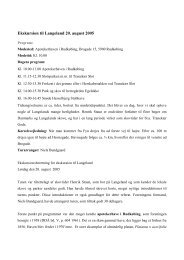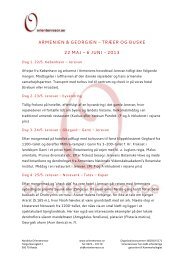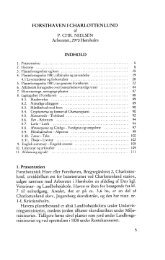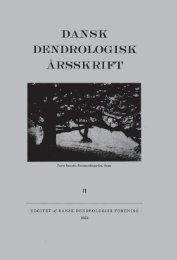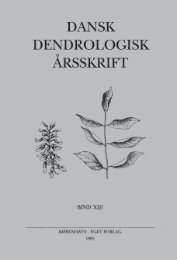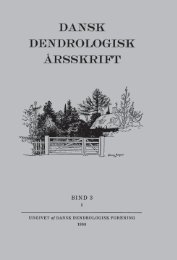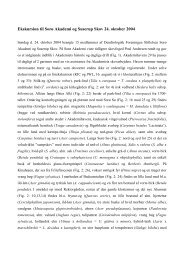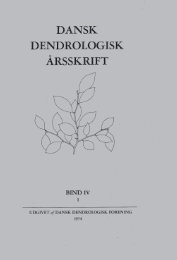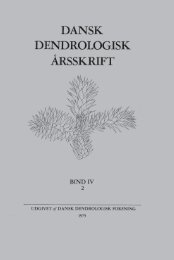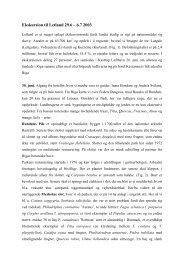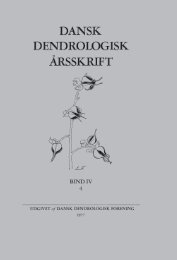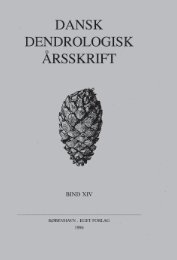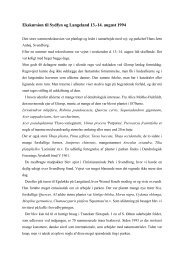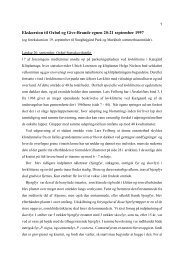Volume 2,1 (1963) - Dansk Dendrologisk Forening
Volume 2,1 (1963) - Dansk Dendrologisk Forening
Volume 2,1 (1963) - Dansk Dendrologisk Forening
Create successful ePaper yourself
Turn your PDF publications into a flip-book with our unique Google optimized e-Paper software.
mostly spread among other trees seldom forming pure stands. Its<br />
needles are linear, often a little curved, dark green to bluish green,<br />
isolateral with lots of stomata on both sides and quite devoid of<br />
serration. The cones are large for a Hemlock, in size and shape reminding<br />
of those of Picea glauca. I have got the impression that it is<br />
a light-loving pioneer tree, but rather slow growing. The top-shoot is<br />
not or only slightly overhanging.<br />
T. Jeffreyi is, as far as I have seen, met with wherever the two<br />
former Tsuga-sipecies grow near each other. The type has quite intermediate<br />
needles, these being slightly serrate, broad linear, with a<br />
considerable number of stomata on the upper side, but to a certain<br />
degree dorsiventral. The cones are nearly half the size of those of<br />
Mertensiana, but have the same Pzcea-like shape. In the Canadian<br />
forest literature it is mentioned that intergrades between Mountain<br />
and Western Hemlock some times may be found in high altitudes,<br />
and I found whenever I climbed to the transition zone between the<br />
two main species that a long series of intermediates as to structure<br />
of leaves and shape of the trees easily could be demonstrated there.<br />
Concerning the cones they seemed to be either heterophylla cones or<br />
cones of Mertensiana-sh&pe varying in size from that of Jeffreyi cone<br />
to that of a true Mertensiana cone.<br />
I am of the opinion that T. Jeffreyi is a hybrid Fl's and backcrosses<br />
both of the parents. As a longliving tree and as a pioneer it<br />
is more often met with than usually is the case in hybrids, and I<br />
should like to call it a woody parallel to the above mentioned Geumhybrid<br />
and like it being of full or nearly full fertility.<br />
6. Picea glauca (Moench) Voss, Picea Engelmanni (Parry) Engelm.<br />
and Picea sitchensis (Bong.) Carr. are three important and apparently<br />
easily distinguishable American trees. Here in Denmark we are<br />
accustomed to find the hybrid between White Spruce and the Sitka<br />
spruce whenever seeds are gathered on Sitkas not too far from White<br />
Spruces. In their homeland they only reach each other in some places<br />
in Alaska, and I was told that hybrids occurred, but I did not go<br />
there. As to P. glauca and P. Engelmanni I was greatly astonished<br />
when Canadian foresters told me that it was quite impossible to<br />
distinguish between these two species, I really did not believe it.<br />
Fortunately I got a chance to study the two trees on several growing<br />
places in the Canadian Cascades and in The Gold Range and in the<br />
Selkirk Mountains. The P. glauca growing there is the very characteristic<br />
variety Albertiana having bark, needles and cones like those<br />
of the common eastern White Spruce but distinguished by hairy



